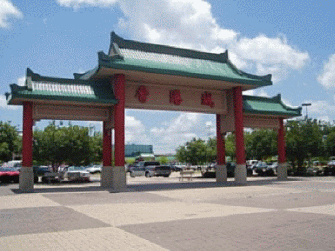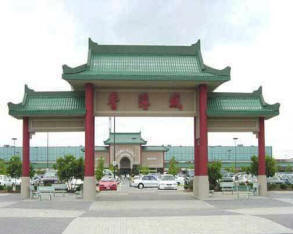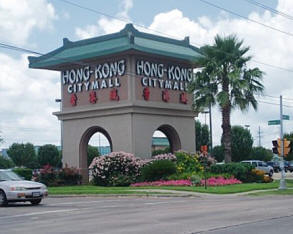History of Houston's Chinatown
By Edward C. M. Chen and Fred R. Von Der Mehden
In 1870 crowds of curious Houstonians gathered to see the arrival of 250 Chinese laborers who were traveling through the city on their way to work on the railroads. Not until a decade later, however, did the census report seven actual residents in the young city. All of these first citizens were in the laundry business, an activity monopolized here by the Chinese in the late nineteenth century. Most of these early residents were male. The 1880 census lists a family consisting of Mr. and Mrs. (Anna, Caucasian) Wah Yuan and son Lincoln (four months), Chinese. Lincoln Yuan was the first Chinese-American born in Houston.
The Houston Chinese community grew very slowly in the prewar years. Until the late 1930s there were fewer than 50 men, women, and children; by World War II they numbered only 121. During the war many people of all races come to the city, and the number of Chinese more than doubled in that period. They came from the surrounding states of Arkansas, Mississippi, and Louisiana, as well as from other parts of Texas. Many had owned small stores in black neighborhoods in the South, and when they came to Houston they opened similar businesses in the predominantly black neighborhoods. These were family enterprises with everyone involved in long hours of work. Still, the community was small in total population, in spite of new laws that allowed more Asians into the United States. It was not until 1955 that the population reached 1,000.

The great expansion of Houston in the post—World War II era has also meant that the Chinese have moved to all parts of the city. Chinese restaurants exist from Memorial to Pasadena, and from Westbury to the area near Intercontinental Airport. Professionals now work at NASA and the University of Houston/Clear Lake City, in downtown offices, and for corporations through out the area. Chinese families today live in every part of metropolitan Houston. Houston does have a small commercial Chinatown along Chartres Street on the eastern edge of the downtown area. The first Chinatown had a variety of flagship merchant services —an area of shops, restaurants, and cultural activities, not residences—was near the present Alley Theatre location on Smith Street. The growth of Houston made expansion difficult there, however, and the Chinese Merchants’ Association decided to move to its present location in the early 1900s. A few of these businesses have been there since the beginning, while others are signs of efforts to rejuvenate the area. A new theater has been built for showing films and presenting cultural events, and it has been particularly attractive to the new Indochinese population who use it as a community center.
Houston Chinatown is a place of good food, Chinese groceries, films, souvenirs, and the offices of the Chinese Merchants’ Association. Driving down Bellaire Blvd. between Boone and Fondren, you will see Chinese street signs, booming shopping centers and business commerce, and plenty of restaurants to feast on. This is the new Chinatown our forefathers dreamed about. Click here to go to the restaurants page and see what Asian restaurants have to offer.
About Us
|
Contact Us |
Terms of Use |
Advertise With Us
|
Job Opportunities |
Sitemap
| RSS
Feeds
![]()
Copyright © 2005 ChinatownConnection.com. Houston Chinatown Portal. All rights reserved

